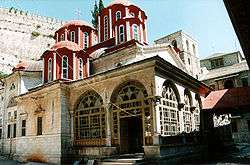Nikola Radonja
| Nikola Radonja | |
|---|---|
| Caesar | |
| Reign | ? — 1364 |
| spouse | Jelena, a sister of Uglješa Mrnjavčević |
| Noble family | Branković dynasty |
| Father | Branko Mladenović |
| Died |
3 December 1399 Agiou Pavlou monastery, Athos |
| Religion | Serbian Orthodox Christianity |
| Occupation | Serbian nobleman and priest |
Nikola Radonja (Serbian: Никола Радоња) or Nikola Radonja Branković or Gerasim or Roman, (c. 1330-1399) was a 14th-century Serbian nobleman and chronicler, a member of the Branković dynasty as the eldest son of Branko Mladenović.
Name
In documents he was referred with one or two out of four different names he had during his life: Nikola, Radonja (Radohna), Roman and Gerasim.[1]
Early life
Radonja was a member of the Branković dynasty as the eldest son of Branko Mladenović. Radonja's younger brothers were Vuk Branković and Grgur Branković.[1] He was married to Jelena, a sister of Uglješa Mrnjavčević.[2] Radonja had a title of caesar (Serbian: ћесар)[3] and controlled an estate in Serres region where he and his wife Jelena lived with their two daughters.[4]
Monastic life
When his wife and daughters died at very young ages, Radonja resigned his feudal position and after Autumn 1364[5][6] took monastic vows and name Gerasim[7] while his father Branko Mladenović was still alive.[8]There he served and helped with great merit Hilendar and also the monasteries of Koutloumousiou and Agiou Pavlou monastery. Thanks to the Radonja's influence, Vuk Branković became the first of Serbian feudal lords who gained ktitor's privileges in Hilandar after the fall of the Serbian Empire, beginning in 1371.[9] The earliest mention of Radonja under his monastic name Gerasim was in a charter of Vuk Branković issued to Hilandar Monastery in 1376/77.[10] Around 1380 Radonja, together with Arsenije Bagaš, bought ruined Agiou Pavlou monastery from Xeropotamou Monastery and reconstructed it.[11][12] In period 1379—89 Radonja was a priest in the Hilandar Monastery and was again mentioned as Gerasim, a brother of Vuk Branković, in the 1389 document written by Prince Lazar.[10] There he achieved hieroschemamonk degree of Eastern Orthodox monasticism.[13] Around 1392 Radonja and group of notable "elders" from Hilandar visited court of the Lazarević family, successors of Prince Lazar, and requested a church in Ibar and its estates to be granted to Hilandar, according to the promise given by its former lord, Obrad Dragoslavić.[14]
After the death of Vuk Branković in 1396, Radonja took Vuk's body to the Agiou Pavlou monastery on Mount Athos.[15]
Radonja died on 3 December 1399 probably in Agiou Pavlou monastery.[11]
Gerasim's Chronicle
Nikola Radonja, as monk Gerasim, was one of the people who appeared in the Serbian 1389 historical drama/war film Battle of Kosovo, in interpretation of the actor Tanasije Uzunović.[16] According to some speculations, Radonja was author of the Gerasim's Chronicle (Serbian: Герасимов летопис), allegedly disappeared at the beginning of the 20th century,[17] which supposedly explains that Miloš killed sultan Murad with a spear during the Battle of Kosovo in 1389.[18]
References
- 1 2 Vizantološki institut (Srpska akademija nauka i umetnosti) (1975). Zbornik radova. Naučno delo. p. 165.
- ↑ Robin Cormack; Elizabeth Jeffreys; Society for the Promotion of Byzantine Studies (Great Britain) (2000). Through the looking glass: Byzantium through British eyes : papers from the twenty-ninth Spring Symposium of Byzantine Studies, London, March 1995. Ashgate. p. 138. ISBN 978-0-86078-667-2.
Subotic and Kissas were able to correct the former readings of the name RADOHNA (Slavonic, 'Radonja') in the inscription and thus to identify the husband of Jelena, UgljeSa's sister. He was Nikola Radonja Brankovic, the eldest son of
- ↑ Melanges Georges Ostrogorsky. Naučno delo. 1991. p. 127.
... кесара BojnxHy, Радохну и Вука БранковиЬа
- ↑ Miladin Stevanović; Vuk Branković (srpski velmoža.) (2004). Vuk Branković. Knjiga-komerc. p. 53.
Најстарији Бранков син Радоња је управљао једном облашћу у Серској области...
- ↑ Đorđe Trifunović (1980). Pisac i prevodilac Inok Isaija. ... p. 20.
Радоња их је сахранио у параклису и после јесени 1364. године отишао у Хиландар
- ↑ Prilozi za književnost, jezik, istoriju i folklor. Državna Štamparija. 2001. p. 77.
поготову откако је 1364. године његов старији брат Никола Радоња, примивши име Роман, постао сабрат српске
- ↑ Recueil de Vardar. Akademija. 2006. p. 5.
- ↑ Cvetan Grozdanov; Ǵorǵi Krsteski; Petar Alčev (1980). Ohridskoto dzidno slikarstvo od XIV vek. Zavod za zaštita na spomenicite na kulturata. p. 17.
Уште додека бил жив севастократорот Бранко, неговиот најстар син Радохна (Радоња) се замонаши
- ↑ Pavle Stojčević (1989). Sveti Knez Lazar: Spomenica o šestoj stogodišnjici Kosovskog boja : 1389-1989. Izd. Svetog arhijerejskog sinoda Srpske pravoslavne crkve. p. 55.
- 1 2 Vranjski glasnik. Narodni muzej u Vranju. 1965. p. 21.
- 1 2 Dimitrije M. Kalezić (2002). A - Z. Savremena administracija. p. 275.
...је око 1380. успео да од манасти- ра Ксиропотама купи запустели манастир Св. Павла и да га из темеља обнови.
- ↑ Vizantološki institut (Srpska akademija nauka i umetnosti) (1965). Posebna izdanja. Naučno delo. p. 112.
После 1360. два српска великаша, Герасим Радоња, брат Вука Бранковића, и Антоније-Арсеније Пагаси...
- ↑ Aleksa Ivić; Dušan Mrđenović; Dušan Spasić; Aleksandar Palavestra (1987). Rodoslovne tablice i grbovi srpskih dinastija i vlastele. Nova knj. p. 87.
- ↑ Vojislav Korać (2000). Colloque scientifique international Huit siecles du monastere de Chilandar: histoire, vie spirituelle, litterature, art et architecture. Sanu. p. 56.
- ↑ Miodrag Al Purković (1978). Knez i despot Stefan Lazarević. Sveti Arhijerejski Sinod Srpske Pravoslavne Crkve. p. 45.
- ↑ Ljubomir Simović (2003). Boj na Kosovu: druga verzija. Stubovi kulture. p. 37.
- ↑ Vojislav Šešelj (1992). Sizifovska sudovanja. ABC Glas. p. 265.
А затим, постоји тај Герасимов летопис који је нестао негде двадесетих или тридесетих
- ↑ "Danas je Vidovdan" (in Serbian). RTS. 2009. Retrieved 21 November 2013.
Treći izvor, "Gerasimov letopis" (Gerasim je brat Vuka Brankovića), kaže da je Miloš probo kopljem Murata.
